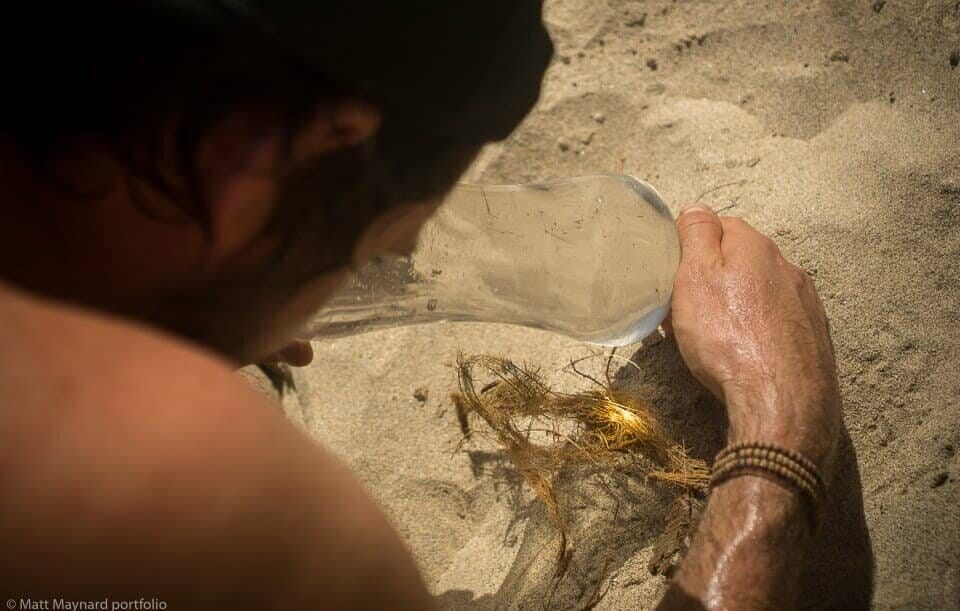
How to Purify Sea Water for Drinking: Techniques Big and Small
Seawater covers about 70% of the Earth’s surface, making it one of the most abundant resources available. However, despite its vast presence, seawater remains undrinkable due to its high salt content. Damn. Can we purify sea water to make it drinkable? The short answer is, yes. Phew. In a world facing increasing water scarcity, learning how to purify sea water into fresh drinking water has become a priority. In this post, we’ll explore the science and technology behind desalination plants, and how it provides clean water to areas that need it the most. Plus, discover how our bushcraft training can equip you with essential survival skills on a desert island, enabling you to turn this abundant resource into a lifesaver. Challenge your inner school science learning and embrace the (reverse) osmosis.

Why Purify Sea Water?
The Earth’s water consists mostly of salt water, leaving us with a limited supply of freshwater resources. With increasing populations and environmental pressures, the need for fresh drinking water is more urgent than ever. Purifying salt water from sea water is a vital process for solving water scarcity, providing a reliable water supply to areas that experience chronic water shortages. But can you really purify sea water to drink? Yes, you can, thanks to advanced desalination technologies, as well as slightly less machine-based methods in the wild.
The Science of Desalination
Desalination is the process of removing salt and dissolved salts from seawater to make it drinkable. This technology is crucial in regions with limited access to freshwater sources, such as the Middle East and parts of California. Desalination plants play a significant role in turning seawater into potable water, supporting agricultural use, and providing clean water to millions.
How Desalination Plants Work
Desalination plants use various methods to desalinate seawater, with reverse osmosis plants being the most prevalent. These plants take in ocean water, filter it through a semipermeable membrane, and remove dissolved salts and impurities to produce fresh water. Reverse osmosis desalination plants rely on high pressure to force water molecules through the membrane, leaving behind saline water and producing clean, desalinated water.
Reverse Osmosis Desalination Plant
Reverse osmosis is a technology that has revolutionized the seawater desalination industry. It operates by applying high pressure to seawater, pushing it through semipermeable membranes that filter out salts and impurities. The result is fresh water on one side of the membrane and concentrated brine on the other. This method is efficient, widely used, and is considered a benchmark in desalination technologies.
Challenges of Desalination
Despite its benefits, desalination is energy-intensive and can be costly. Additionally, the logistical challenges to transport fresh water from coastal plants to inland areas can further increase costs, sometimes rivalling the costs of desalination itself. High pressure pumps and energy costs make desalinated water more expensive than traditional freshwater sources. However, advances in technology and increased investment in renewable energy sources aim to down environmental costs and make desalination more cost-effective and sustainable.
Environmental Impact and Innovations
Desalination, while vital, does come with environmental impacts. The energy cost of running desalination plants is significant, and the concentrated brine discharge can affect marine life, not ideal if you are living on a desert island. Environmental science research is focused on minimizing these impacts by developing less energy-intensive methods of drinking salt water and improving the efficiency of existing systems.
Solar Desalination: Harnessing the Sun’s Power
Solar desalination is an innovative approach that uses solar energy to purify sea water. By evaporating water using solar heat and then condensing the water vapour, this method mimics the natural water cycle. Solar desalination offers an environmentally friendly alternative, particularly in sunny regions, reducing energy costs and environmental impact.
Fresh Water from Salt Water: Is It Possible at Home?
While large-scale desalination plants provide fresh water to cities, smaller systems can be used at home. Home-based desalination units, like countertop distillers, can desalinate seawater on a smaller scale. These units boil water, collect the water vapor, and condense it into distilled and purified water afterwards, leaving salt and impurities behind. While not as efficient as industrial systems, they provide an option for those needing to purify salty water in smaller quantities.
The Role of the International Desalination Association
The International Desalination Association (IDA) is a leading organization dedicated to advancing desalination technologies. It promotes research, collaboration, and education to address water scarcity challenges worldwide. The IDA’s efforts are crucial in fostering innovations that make desalination more accessible and environmentally friendly.
Seawater Reverse Osmosis: A Global Solution
Seawater reverse osmosis (SWRO) systems are deployed globally, providing fresh drinking water to regions with limited water resources. These systems use high pressure pumps to move seawater through RO membranes, effectively reducing water salinity and producing potable water. As water scarcity becomes more pronounced, seawater reverse osmosis systems continue to offer a sustainable solution to water shortage.
Join Our Island Adventures
Inspired to learn more about purifying sea for safe drinking water, and living off the land? Join one of our Island Bushcraft Adventures, where you can experience survival techniques firsthand and discover the beauty of self-reliance. Our expeditions offer the perfect opportunity to explore the wonders of nature while learning valuable skills to purify sea water and thrive in challenging environments.
FAQs
Yes, through processes such as reverse osmosis and distillation, seawater can be purified to produce drinkable water.
Ocean water is made drinkable by removing salt and impurities from surface water through desalination processes like reverse osmosis.
Boiling ocean water alone will not make it drinkable as it does not remove salt. Desalination or distillation is needed to remove the salt content.
Desalination can be costly due to the large quantities of energy required, but advancements in technology aim to reduce these costs and make the process more sustainable.
Desalination is energy-intensive and can have environmental impacts, which limits its widespread adoption. However, it remains a vital solution in regions with limited freshwater resources.







